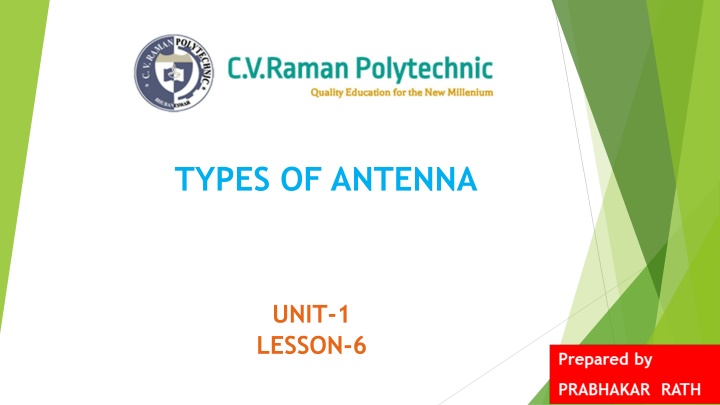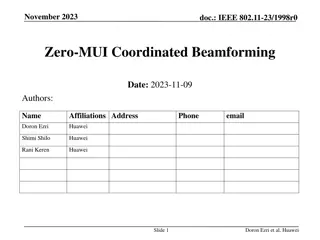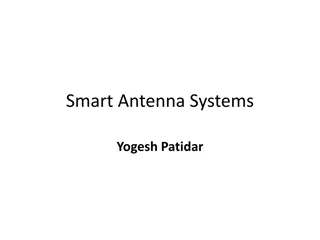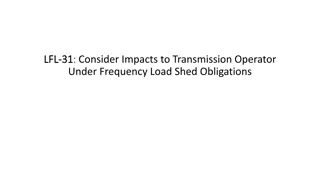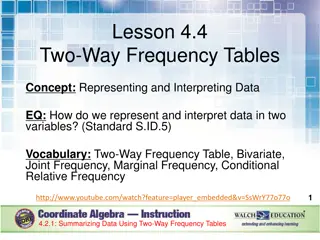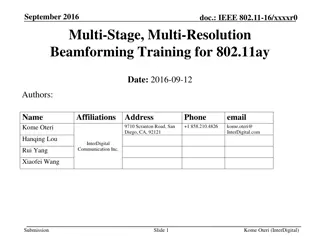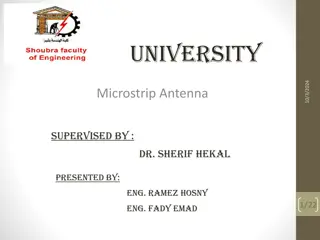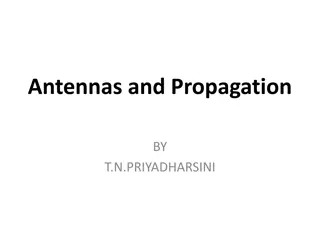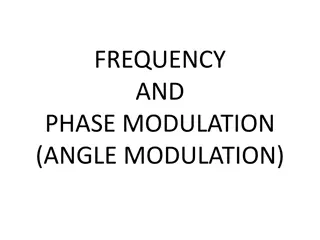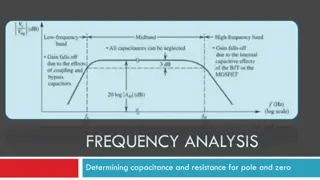Types of High Frequency Antennas: Yagi-Uda & Rohmbus
Directional high frequency antennas, such as Yagi-Uda and Rohmbus, are commonly used for TV reception and various communication applications. These antennas offer high gain, directivity, and performance. Learn about their structures, elements, and advantages in this informative guide.
Download Presentation

Please find below an Image/Link to download the presentation.
The content on the website is provided AS IS for your information and personal use only. It may not be sold, licensed, or shared on other websites without obtaining consent from the author.If you encounter any issues during the download, it is possible that the publisher has removed the file from their server.
You are allowed to download the files provided on this website for personal or commercial use, subject to the condition that they are used lawfully. All files are the property of their respective owners.
The content on the website is provided AS IS for your information and personal use only. It may not be sold, licensed, or shared on other websites without obtaining consent from the author.
E N D
Presentation Transcript
TYPES OF ANTENNA UNIT-1 LESSON-6
CONTENT Types of antenna Directional high frequency antenna (Yagi-Uda & Rohmbus) UHF & Microwave antenna (Dish antenna with parabolic reflector & Horn antenna) Basic concepts of smart antenna.
TYPES OF ANTENNA TYPES OF ANTENNA Lens Antennas Micro strip Antennas Reflector Antennas Array Antennas Aperture Antennas Wire Antennas Dipole antenna, Monopole antenna, Helix antenna, Loop antenna Convex-plane, Concave-plane, Convex-convex, Concave concave lenses Circular-shaped, Rectangular shaped metallic patch above the ground plane Parabolic reflectors, Corner reflectors Yagi-Uda antenna, Micro strip patch array, Waveguide (opening), Horn antenna Personal applications, buildings, ships, automobiles, space crafts Microwave communication, satellite tracking, radio astronomy Air-craft, space- craft, satellites, missiles, cars, mobile phones etc. Flush-mounted applications, air-craft, space craft Used for very high frequency applications Used for very high gain applications
DIRECTIONAL HIGH FREQUENCY ANTENNA (YAGI-UDA ANTENNA) Yagi-Uda antenna is the most commonly used type of antenna for TV reception over the last few decades. It is the most popular and easy-to- use type of antenna with better performance, which is famous for its high gain and directivity The frequency range in which the Yagi-Uda antennas operate is 3GHz which belong to the VHF and UHF bands. A Yagi-Uda antenna was seen on top of almost every house during the past decades. The feeder is the folded dipole. The reflector is the lengthy element, which is at the end of the structure. around 30 MHz to
DIRECTIONAL HIGH FREQUENCY ANTENNA (YAGI-UDA ANTENNA) The center rod like structure on which the elements are mounted is called as boom. The element to which a thick black head is connected is the driven element to which the transmission line is connected internally, through that black stud. The single element present at the back of the driven element is the reflector, which reflects all the energy towards the direction of the radiation pattern. The other elements, before the driven element, are the directors, which direct the beam towards the desired angle.
DIRECTIONAL HIGH FREQUENCY ANTENNA (YAGI-UDA ANTENNA) Advantages: High gain is achieved. High directivity is achieved. Ease of handling and maintenance. Less amount of power is wasted. Broader coverage of frequencies. Disadvantages: Prone to noise. Prone to atmospheric effects. Applications: Mostly used for TV reception. Used where a single-frequency application is needed
DIRECTIONAL HIGH FREQUENCY ANTENNA ( ROHMBUS ANTENNA) The Rhombic Antenna is an equilateral parallelogram shaped antenna. Generally, it has two opposite acute angles. Rhombic antenna works under the principle of travelling wave radiator. It is arranged in the form of a rhombus or diamond shape and suspended horizontally above the surface of the earth. The frequency range of operation of a Rhombic antenna is around 3MHz to 300MHz. This antenna works in HF and VHF ranges. Rhombic antenna can be regarded as two V-shaped antennas connected end-to-end to form obtuse angles. The two sides of rhombus are considered as the conductors of a two- wire transmission line. When this system is properly designed, there is a concentration of radiation along the main axis of radiation. The maximum gain from a rhombic antenna is along the direction of the main axis, which passes through the feed point to terminate in free space.
DIRECTIONAL HIGH FREQUENCY ANTENNA ( ROHMBUS ANTENNA) Advantages: Input impedance and radiation pattern are relatively constant Multiple rhombic antennas can be connected Simple and effective transmission Disadvantages: Wastage of power in terminating resistor Requirement of large space Reduced transmission efficiency Applications: Used in HF communications Used in Long distance sky wave propagations Used in point-to-point communications
UHF & MICROWAVE ANTENNA (DISH ANTENNA WITH PARABOLIC REFLECTOR) Parabolic Reflectors are Microwave antennas. The frequency range used for the application of Parabolic reflector antennas is above 1MHz. If a Parabolic Reflector antenna is used for transmitting a signal, the signal from the feed, comes out of a dipole or a horn antenna, to focus the wave on to the parabola. It means that, the waves come out of the focal point and strike the Paraboloidal reflector. The same antenna is used as a receiver. When the electromagnetic wave hits the shape of the parabola, the wave gets reflected onto the feed point. The dipole or the horn antenna, which acts as the receiver antenna at its feed, receives this signal, to convert it into electric signal and forwards it to the receiver circuitry.
UHF & MICROWAVE ANTENNA (DISH ANTENNA WITH PARABOLIC REFLECTOR) There are two types of feed method 1/ Cassegrain Feed 2/ Gregorian Feed
UHF & MICROWAVE ANTENNA (DISH ANTENNA WITH PARABOLIC REFLECTOR) Advantages: Reduction of minor lobes Wastage of power is reduced Equivalent focal length is achieved Feed can be placed in any location, according to our convenience Adjustment of beam (narrowing or widening) is done by adjusting the reflecting surfaces Disadvantage: Some of the power that gets reflected from the parabolic reflector is obstructed. This becomes a problem with small dimension paraboloid. Applications: The cassegrain feed parabolic reflector is mainly used in satellite communications. Also used in wireless telecommunication systems.
UHF & MICROWAVE ANTENNA (HORN ANTENNA) To improve the radiation efficiency and directivity of the beam, the wave guide should be provided with an extended aperture. So that all the energy in the forward direction gets radiated. This can be termed as Flaring. Now, this can be done using a horn antenna. The operational frequency range of a horn antenna is around 300MHz to 30GHz. This antenna works in UHF and SHF frequency ranges.
UHF & MICROWAVE ANTENNA (HORN ANTENNA) Construction & Working of Horn Antenna The energy of the beam when slowly transform into radiation, the losses are reduced and the focussing of the beam improves. A Horn antenna may be considered as a flared out wave guide, by which the directivity is improved and the diffraction is reduced. The flared wave guide can be technically termed as Electromagnetic Horn Radiator. Radiation Pattern
UHF & MICROWAVE ANTENNA (HORN ANTENNA) Advantages: Small minor lobes are formed Impedance matching is good Greater directivity Narrower beam width Disadvantages: Designing of flare angle, decides the directivity Flare angle and length of the flare should not be very small Applications: Used for astronomical studies Used in microwave applications
BASIC CONCEPTS OF SMART ANTENNA Smart Antennas, also known as multiple antennas, adaptive array antennas, and so on is used to increase the efficiency in digital wireless communication systems. It works by taking the advantage of the diversity effect at the transceiver of the wireless system that is the source and the destination. The term diversity effect refers to the transmission and reception of multiple radio frequencies that are used to decrease the error during data communication and also to increase data speed between the source and the destination.
BASIC CONCEPTS OF SMART ANTENNA Difference between Conventional Antenna and Smart Antenna The main difference is related with the way both the systems deal with the problems caused by multipath wave propagation. When a wireless signal is sent to a large distance it may have to pass many barriers like tall buildings, mountains, utility wires and so on. Thus these signals wave fronts will be scattered and will take multiple paths to reach the receiver. In a conventional wi-fi communication system, a method called single input single output [SISO] is used, that is one antenna will be connected to the source and another one will be connected to the destination. When the signals arrive late at the destination, they may arrive faded, cut-out and also with common communication problems like picket fencing. This is one of the basic problems of a SISO system. Thus if we use SISO system in a internet connection, the data will arrive late and that too erroneous in nature. All these problems can be solved with the help of Smart Antennas.
BASIC CONCEPTS OF SMART ANTENNA Advantages: It uses narrow pencil beams. High efficiency Disadvantages: Cost: The cost of such a device will be more, not only in the electronics section, but also in the power. That is the device is way too expensive [especially if MIMO methods are used.], and will also decrease the life of battery of mobiles. Size : For this method to be efficient large base stations are needed. This will increase the size. Apart from this multiple external antennas are needed on each terminal. This is not practical. But companies re trying methods like dual polarization to reduce the size. Diversity: When multiple mitigation is needed, diversity becomes a big problem. The terminals and base stations must have multiple antennas.
ASSIGNMENT What is parabolic reflector antenna. What is smart antenna. What is horn antenna.
THANK YOU
